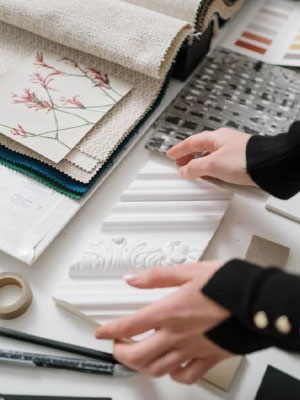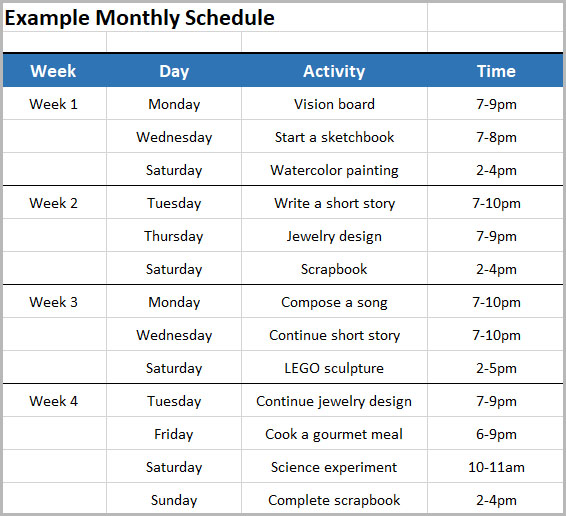Table of Contents
ToggleAchieve 10 creative activities in one month
Achieving 10 creative activities in one month provides a structured yet flexible framework to explore various creative pursuits, enhancing your skills and fostering personal growth. This goal encourages you to prioritize and manage your time effectively, ensuring that each activity is given adequate attention and effort. By breaking down the activities into manageable steps and scheduling them throughout the month, you create a balanced routine that prevents burnout and maintains enthusiasm.
Utilizing planning tools and setting small rewards for completion keeps you motivated and accountable while allowing for adjustments to ensure that unexpected delays do not derail your progress. Completing these 10 creative activities within a month not only enhances your creativity and productivity but also provides a sense of accomplishment and satisfaction.
Setting and achieving 10 creative activities in one week requires careful planning, prioritization, and time management. Here’s a step-by-step guide to help you accomplish this:
Plan a creative activity
Step 1: Identify Your Creative Activities
Choose 10 creative activities you want to accomplish. Here’s an example list:
- Create a vision board.
- Write a short story.
- Paint a watercolor.
- Design a piece of jewelry.
- Compose a song.
- Build a LEGO sculpture.
- Cook a gourmet meal.
- Start a sketchbook.
- Make a scrapbook.
- Do a science experiment.

Step 2: Assess the Time Requirement
Estimate how much time each activity will take and how many sessions you need to complete each activity (example):
- Vision board: 2 hours
- Short story: 6 hours (2 sessions)
- Watercolor painting: 4 hours (2 sessions)
- Jewelry design: 4 hours (2 sessions)
- Song composition: 6 hours (2 sessions)
- LEGO sculpture: 3 hours
- Gourmet meal: 3 hours
- Sketchbook start: 1 hour
- Scrapbook: 4 hours (2 sessions)
- Science experiment: 1 hour

Step 3: Allocate Weekly Time Slots
Distribute the activities across the month. Aim to complete 2-3 activities per week (example).
Week 1:
- Vision board (2 hours) – Monday evening
- Start a sketchbook (1 hour) – Wednesday evening
- Watercolor painting (2 hours) – Saturday afternoon
Week 2:
- Write a short story (3 hours) – Tuesday evening
- Jewelry design (2 hours) – Thursday evening
- Scrapbook (2 hours) – Saturday afternoon
Week 3:
- Compose a song (3 hours) – Monday evening
- LEGO sculpture (3 hours) – Saturday afternoon
- Continue short story (3 hours) – Wednesday evening
Week 4:
- Continue jewelry design (2 hours) – Tuesday evening
- Cook a gourmet meal (3 hours) – Friday evening
- Complete scrapbook (2 hours) – Sunday afternoon
- Science experiment (1 hour) – Saturday morning
Step 4: Schedule Breaks and Buffer Time
Allow for relaxation and buffer time in case activities take longer than expected.
Include periods of relaxation and buffer time in your schedule to ensure you have the flexibility to accommodate activities that may take longer than expected. This means scheduling short breaks between tasks and setting aside extra time at the end of each day or week. This way, you won’t feel rushed or stressed if an activity runs over its allotted time.
For example, if you plan to spend two hours painting but it takes three, the additional buffer time can absorb the extra hour, preventing it from affecting your other planned activities. Additionally, relaxation periods can help you recharge, maintain creativity, and avoid burnout, ensuring you remain productive and motivated throughout the month.

Step 5: Use Tools for Tracking
Use a planner, digital calendar, or task management app to track your activities. Set reminders for each task.
Utilize a planner, digital calendar, or task management app to track and manage your creative activities effectively. Choose a tool that suits your preferences and lifestyle. For instance:
Planner:
- Use a physical planner where you can write down your daily, weekly, and monthly schedules.
- Color-code your activities to differentiate between various types of tasks.
- Regularly update your planner with new tasks or changes in your schedule.
Digital Calendar:
- Use a digital calendar like Google Calendar or Apple Calendar.
- Input all your creative activities and allocate specific time slots for each task.
- Enable notifications to receive reminders before each activity begins.
- Share your calendar with others if you need to coordinate with family or colleagues.
Task Management App:
- Choose a task management app such as Todoist, Trello, or Asana.
- Create a project or board dedicated to your creative activities.
- Break down each activity into smaller tasks or steps and assign due dates.
- Use features like labels, priorities, and deadlines to organize and prioritize your tasks.
- Set reminders and recurring tasks to keep track of ongoing projects and deadlines.
Regularly check and update your planner, calendar, or app to stay on top of your schedule. Setting reminders for each task ensures that you don’t forget any planned activities and helps you stay focused and on track. Additionally, having a visual representation of your schedule allows you to see your progress and adjust your plans as needed.
Step 6: Prepare Materials in Advance
Prepare thoroughly by ensuring you have all the necessary materials and tools ready before starting each activity. This proactive approach prevents delays and helps you stay focused and productive. Follow these steps:
- Create a Materials Checklist:
- For each creative activity, list all the materials and tools you will need. For example, if you are painting, your list might include brushes, paints, canvases, a palette, water, and rags.
- Use your checklist to gather items well in advance.
- Organize Your Supplies:
- Keep your materials and tools organized in a dedicated space. Use storage bins, shelves, or drawers to keep everything in order.
- Label storage containers so you can easily find what you need when you need it.
- Prepare Your Workspace:
- Set up a clean, well-lit workspace that is conducive to your creative activity. Ensure you have enough room to work comfortably.
- Arrange your tools and materials within easy reach to minimize interruptions.
- Check Inventory Regularly:
- Regularly check your inventory to ensure you have enough supplies. Replenish items that are running low.
- Make a habit of reviewing your materials checklist a few days before starting an activity to allow time for any necessary purchases.
- Plan for Specific Needs:
- Consider any special requirements for each activity. For example, if you are cooking a gourmet meal, ensure you have all ingredients, utensils, and appliances ready.
- If an activity requires specialized tools or materials, plan ahead to acquire them. This might involve ordering online or visiting a specialty store.
- Prepare Backup Supplies:
- Keep backup supplies for essential items. For example, have extra batteries for electronic tools or spare brushes for painting.
- This ensures you can continue working even if something goes wrong.
- Time Your Preparation:
- Allocate specific times in your schedule for preparing materials. For instance, spend an hour on Sunday gathering and organizing supplies for the week’s activities.
- Doing this ensures that preparation does not eat into your creative time.
- Stay Flexible:
- Be ready to adapt if something is missing. Have alternative plans or materials in mind so you can adjust without significant delays.

Step 7: Stay Flexible and Adjust
Be prepared to adjust your schedule as needed. Flexibility is key to managing your time effectively. Here’s how:
- Monitor Progress:
- Track time spent on each activity. Note if a task takes longer than planned.
- Use your planner or digital calendar to log actual vs. estimated time.
- Anticipate Changes:
- Recognize that unforeseen events can arise. Plan for buffer time each week to catch up on tasks.
- Reprioritize:
- Identify and focus on the most important tasks first. Use the Eisenhower Matrix to reassess priorities when needed.
- Communicate:
- Inform others of any changes in your schedule promptly.
- Adjust Schedule:
- Move less critical tasks to later dates. Allocate extra time slots as needed.
- Utilize Flex Time:
- Incorporate ‘flex time’ in your schedule for overrunning tasks or unexpected commitments.
- Stay Calm:
- Maintain a calm and adaptable mindset. View changes as opportunities to improve time management.
- Evaluate:
- Review your accomplishments and adjustments at the end of each day or week. Reflect on what caused delays and how to manage them better in the future.
- Maintain Balance:
- Ensure that schedule adjustments do not compromise your personal time and well-being. Balance is crucial for sustained productivity.
- Set Realistic Goals:
- Set achievable goals for each day and week. Avoid overloading your schedule to allow for quality work without feeling rushed.
By staying flexible and prepared, you can handle unexpected changes smoothly and keep your creative activities on track, reducing stress and maintaining productivity.

Step 8: Stay Motivated
Keep yourself motivated by setting small rewards for completing each activity. Celebrate your accomplishments at the end of each week.

All trademarks, logos, and brand names are the property of their respective owners. All company, product, and service names used in this website are for identification purposes only. Use of these names trademarks, and brands do not imply endorsement.





2 thoughts on “Achieve 10 creative activities in one month”
Comments are closed.